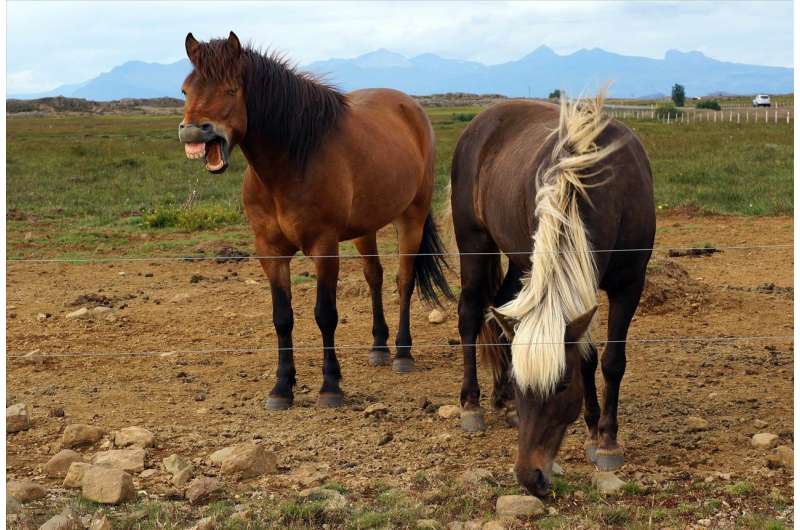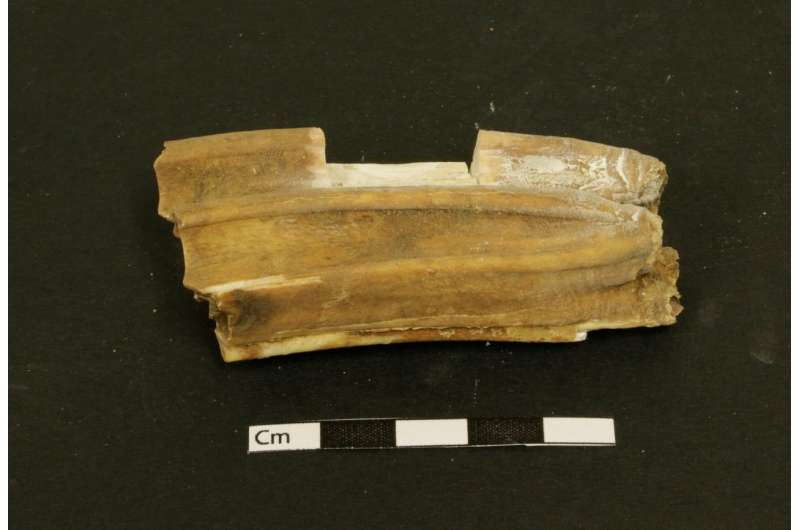Modern Icelandic horses are probably descendants from the horses that were buried by Vikings more than 1000 years ago. Credit: Albina Hulda Pálsdottir
Archaeologists in Iceland have for decades examined the remains of more than 350 graves from the Viking Age. In approximately 150 examples, teeth or bones of horses were found. Geneticists and archaeologists have now examined ancient DNA from 19 horses in such graves, and found that all the horses except one were male.
Iceland was a heavily forested, uninhabited island until the Vikings settled there in the 870s. The first Vikings were, according to stories in the Landnámabók, noblemen with their families who traveled to Iceland to get away from the harsh rule of King Harald Fairhair. Around 930, the population of Iceland had already increased to 9000, and it is therefore puzzling that only 350 graves dating to the Viking Age have been found so far.
"There should be thousands of such graves," says Ph.D. student Albína Hulda Pálsdottir at CEES, Department of Biosciences at the University of Oslo. As a zooarchaeologist, she is an expert in studying animal remains from archaeological excavations.
The modest number of Viking graves makes it all the more interesting to study those that have been found. Researchers hope for better insight into how the Vikings of Iceland lived and thought. Now, they present a clearer picture of the Viking burial ritual. A multidisciplinary research team of archaeologists and geneticists from Iceland, Norway, Denmark, the United Kingdom and France have examined ancient DNA (aDNA) from 19 horses found in these graves.
"It is reasonable to believe that a Viking who received a horse in the grave must have had a certain amount of power and influence. We would therefore like to know more about these horses, for example, of which sex they were," says Pálsdottir.
Ancient DNA revealed the horses' sex
But it is not easy to determine the sex of bone fragments and teeth from horses more than 1000 years old. Male and female horses are quite similar, both in size and appearance. Zooarchaeologists have previously tried to sex horse remains from the Vikings' graves by looking at the canines and pelvis, and they found that most horses were male – stallions or geldings. The pelvises of male horses look different from those of female horses, and in most cases, males have large canines while most mares do not have canines at all.
"These morphological sexing methods can't always be used when the skeletons are badly preserved. Often, the burial remains don't contain any canines or pelvic bones. We have therefore sexed the remains of 19 horses from Viking age graves in Iceland by analyzing the ancient DNA preserved in the fragments. Then it turned out that 18 of them were male," says Sanne Boessenkool. She is also based at CEES at the Department of Biosciences.
The horses in the burials were in their prime; they were thus not buried because of old age or illness. Sanne Boessenkool, who is a biologist and expert in evolution and the analysis of ancient DNA, adds that DNA remains cannot provide answers to whether the buried male animals were stallions or geldings (castrated animals).
Stallions as symbols of power
The Arctic fox, also called the polar fox, was the only land mammal that existed in Iceland before people settled there. But this changed quickly when the Vikings arrived and imported animals such as dogs, sheep, cows, pigs, goats, chickens and horses. In the end, there were many horses in Iceland, and archaeologists have therefore been uncertain what it meant when a Viking was buried with a horse. But when 18 of the 19 buried horses analyzed turned out to be male, the researchers concluded that there appears to have been a conscious choice to place a male horse in a burial.
"It is natural to imagine that the slaughter of the virile and to some extent aggressive male animals must have been part of a burial ritual that was intended to convey status and power," explains archaeologist Rúnar Leifsson from The Cultural Heritage Agency of Iceland (Minjastofnun Íslands). He is one of the collaborators on the scientific paper, now published in the Journal of Archaeological Sciences.
"In addition to the 19 buried horses, we have examined the remains of three horses that were found outside graves. All of these were female," says Sanne Boessenkool. These horses had not been given a ceremonial funeral, and were likely eaten. The impression is therefore that male and female animals had a different status.
New light shed on graves
It has been a challenge to interpret the grave remains from the Viking Age in Iceland, because many of the graves were found during road works or other construction projects between 50 and 100 years ago. In many cases, the burials were not examined by an archaeologist and only a small part of the material found was sent back to the National Museum of Iceland. Therefore, most of the skeletons are incomplete.
"It is striking that we find almost exclusively middle-aged men in the graves on Iceland. There are almost no infants or children, and very few women. We don't know how the rest of the population was buried. Perhaps they were laid in swamps or lakes, or sunk in the sea," suggests Pálsdottir.
It is also striking that the Vikings in Iceland apparently developed their own burial customs.
"It was common to cremate the dead in Scandinavia, where the Vikings of Iceland came from. But we find no traces of cremation on Iceland. Other scientists have studied the occurrence of different isotopes in the Viking skeletons, and it turned out that the buried women who were found must have come to Iceland during adulthood. This may indicate that the men from the first settlement brought women to Iceland from Scandinavia," suggests Pálsdottir.
Method: The researchers cut a small piece from a canine, cleaned it, and extracted enough ancient DNA to determine the sex of the animal that was buried by Vikings on Iceland. Credit: Albina Hulda Pálsdottir, UiO
The Vikings didn't think like us
Sanne Boessenkool stresses that we should not mirror our own modern cultural ideas when we attempt to interpret the grave finds from Viking Age Iceland.
"Today, we think of death and a funeral as an ending, and then it may seem wasteful to slaughter a great stallion just to bury it. But if the people at the time believed in a life after death, they maybe thought that the horse had a function," suggests Boessenkool.
Albína Hulda Pálsdottir agrees:
"Nowadays, it is easy to imagine such rituals as a form of demonstrating power, perhaps as 'conspicuous consumption' that was intended to demonstrate wealth and status, rather than to cover real needs. But maybe the Vikings thought totally different," Pálsdóttir says.
The term 'conspicuous consumption' was introduced by the Norwegian-American economist and sociologist Thorstein Veblen, who felt that the motivation of such behavior was to demonstrate power and prosperity, rather than to satisfy one's own desires and needs.
Skulls on stakes
Researchers have in some cases been able to see how the animals were killed before they were placed in Viking graves.
"If a horse skull has a fracture on the forehead, it is very clear that it was slaughtered with a hit on the forehead. There are also a few cases where the horse has been beheaded, meaning the head has been separated from the rest of the body. An interesting example that is not included in our study comes from the farm at Hofstaðir in northern Iceland. There archaeologists found many cattle skulls with fractures in the forehead that showed weathering on the front, but not on the back," says Pálsdóttir.
Archaeologists inferred that these animals had been killed ceremonially, possibly in connection with a festivity where skulls were put on stakes outside the Viking hall, perhaps as a sign of warning; an enemy may think twice before approaching a Viking farm surrounded by skulls on stakes. Weathering suggests that the skulls must have been left on display long enough for the weather and wind to leave marks on the exposed side of the skull.
The ancestors of the Icelandic horse
Albína Hulda Pálsdottir and Sanne Boessenkool emphasize that the horses that existed in Iceland under the Viking Age are not necessarily exactly the same as modern Icelandic horses.
"The horse breeds we have today were bred up in the course of the last 200 years or so, but the horse bones we have examined are, of course, much older. But we can assume that these horses are the ancestors of the Icelandic horses today," Boessenkool says.
The researchers at CEES are now working on sexing the remains of several animal species from the Viking Age using ancient DNA. "In the course of this project, we have developed a simple method for sex determination using ancient DNA. It is an important advance, because it would not have been possible to sex over half of the horses in the study with other methods," Boessenkool explains.
"The method is fairly easy to use for all species that have sex chromosomes, and we have shown that the method is robust. We also do not need a lot of DNA to get secure results, so we expect that other researchers will take advantage of the method we present in the paper," she adds.
Most aDNA from bacteria
The researchers' method is described in more detail in the scientific article, but the first step is to clean a tooth or a bone. Then the researchers cut out a sample that is crushed into powder, from which DNA is extracted. The DNA is then analyzed using a method called shotgun sequencing, by which the researchers sequence all the DNA in the sample. But in a tooth from the Viking Age, there can be a lot of DNA that comes from other organisms:
"Most of the old DNA we find is not actually from horse. In some cases, as much as 99.5 percent is from bacteria or undefined organisms," Boessenkool says.
More information: Heidi M. Nistelberger et al. Sexing Viking Age horses from burial and non-burial sites in Iceland using ancient DNA, Journal of Archaeological Science (2018). DOI: 10.1016/j.jas.2018.11.007
Journal information: Journal of Archaeological Science
Provided by University of Oslo
























